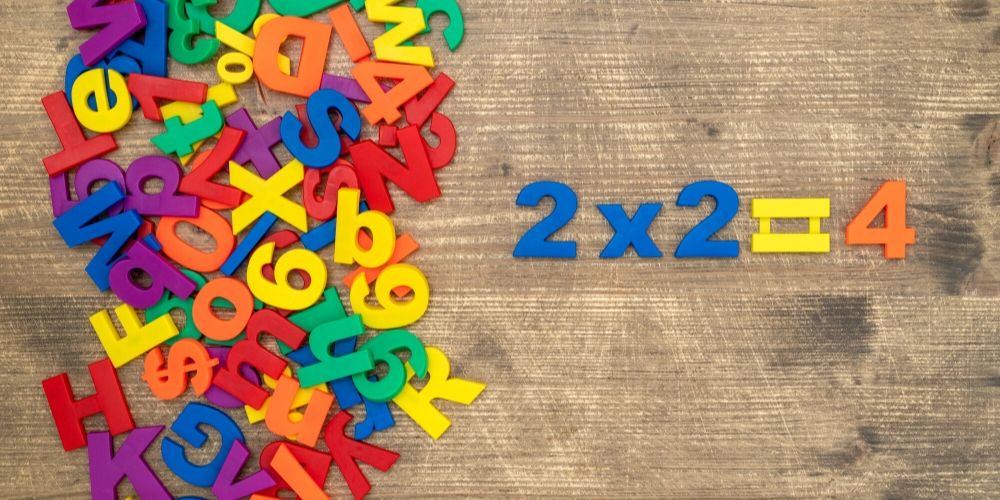I’ll never forget being in grade three, bouncing between three different schools in one year. Each school was teaching multiplication at a different pace—and I was always either behind or ahead. At one school, I was totally average. At the next, they looked at me like I hadn’t passed second grade. By the third, I was back on track, but the damage to my confidence had already been done.
I remember sitting in class, watching kids fly through their times tables while I felt completely lost. I was embarrassed. I felt dumb. Kids teased me. My mom, probably desperate to help, offered me $100 to memorize them. I did it—and promptly forgot them just as fast.
Looking back, I wish someone had shown me the simple tricks I’m about to share with you here. Because memorizing facts is one thing—but actually understanding multiplication in a way that clicks? That’s what makes it stick. These are the hacks I wish I had as a kid, and now as a mom, I love passing them on.
Let’s get started.
You Already Know More Than You Think
Before diving into new tricks, let’s start with a confidence boost: if your child knows how to count by 2s, 5s, or 10s, they already have a solid head start on multiplication.
Think about it. The 1s are automatic—anything times 1 is just itself. The 10s? Just add a zero. The 2s and 5s follow a rhythm most kids pick up early, especially if they’ve practiced skip counting. And even the 11s (up to 9 × 11) are just repeating digits. These are wins you can stack up quickly.
What’s left after that? Not a scary mountain—just a few hills. When kids realize they only need to focus on learning a handful of harder facts (like 6s, 7s, and 8s), the whole subject feels more manageable.
Sometimes, the biggest trick is just showing them how much they already know.
The 9s Finger Trick: Still Blows My Mind
Out of all the multiplication tricks out there, the one for 9s is hands-down my favorite. I didn’t learn it until adulthood, and honestly, I was a little mad no one showed it to me as a kid. It would’ve saved me so much stress (and maybe $100).
Here’s how it works:
- Hold out both hands, fingers spread.
- To multiply 9 × 3, fold down your third finger.
- Count the fingers to the left of the folded one (2), and the fingers to the right (7).
- Your answer: 27.
It works for everything from 9 × 1 to 9 × 10. It’s visual, it’s hands-on, and it’s oddly satisfying. Kids love it because it feels like a magic trick—until they realize it’s just smart math.
The Trick That Helped Me Understand 3s
Some multiplication facts just don’t stick the first time around—3s were that for me. They’re not quite rhythmic like 5s or as obvious as 10s. But this one method finally helped me “get it,” and I’ve seen it work wonders with kids too.
The idea is simple: turn the 3 times table into a pattern or chant. A lot of kids respond well to music, repetition, or visual cues. This method uses a mix of counting, highlighting patterns, and reinforcement through rhythm. It’s not just “repeat after me”—it actually builds familiarity.
If your child is struggling with 3s, this system breaks it down in a way that feels less like brute-force memorization and more like understanding.
Bonus tip: Try having your child write the 3s out loud while repeating them in a pattern (e.g., 3, 6, 9, 12…)—add a beat, make it silly. The more senses involved, the better it sticks.
6, 7, 8 Finger Trick: It’s Not Magic, Just Smart
Once you hit the 6s, 7s, and 8s, things usually get trickier. These don’t follow the obvious patterns like the 10s or 5s, and they’re often where kids start to freeze up. That’s where this finger trick comes in—one I wish I’d learned way earlier.
Here’s the gist:
- Assign each finger on both hands a value from 6 to 10, starting with your pinky (left pinky = 6, ring = 7, middle = 8, index = 9, thumb = 10).
- To multiply 7 × 8, touch your left ring finger (7) to your right middle finger (8).
- Count all the fingers touching and below—those are your tens (3 on each hand = 6, so 60).
- Multiply the remaining fingers above (3 on one hand × 2 on the other = 6).
- Add them together: 60 + 6 = 66.
It sounds more complicated than it is—but once you see it, it clicks fast. It turns abstract numbers into something kids can touch and see.
This trick is best once your child already knows their 1s through 5s. It gives them a physical anchor when the numbers get tougher, especially for visual or kinesthetic learners.
A Different Way to See the 9s Pattern
If the finger trick didn’t quite click—or if your child just learns better by seeing patterns—this method for learning the 9 times table is a great backup. And honestly, even if they already know the finger trick, this one is worth showing just for how cool the pattern is.
Here’s what you do:
- Write down the numbers 0 through 9 in a column.
- Right next to them, write 9 through 0 going up.
- You’ll end up with:
- 09
- 18
- 27
- 36
- 45
- 54
- 63
- 72
- 81
- 90
See the symmetry? Every answer adds up to 9. And the digits mirror each other in a satisfying pattern. Once kids notice this, it turns a memorization chore into a puzzle.
Not every child connects with the same trick, so having more than one approach is helpful. Some will respond to hands-on learning, others to visual patterns. The goal is always the same: make multiplication feel less like guesswork and more like something they get.
Turn Practice into Play: My Favorite Dice Game
If there’s one thing I’ve learned as a parent, it’s this: the more fun something is, the more likely your kid will actually do it. That’s why I love turning multiplication practice into a game—no worksheets required.
Here’s a simple one that works like magic:
🎲 The Dice Game
- Grab two 10-sided dice (you can find them in most board game sets or online).
- Take turns rolling the dice.
- Multiply the two numbers together—fastest correct answer wins the round.
It’s easy to set up, surprisingly competitive, and perfect for car rides, dinner tables, or even five-minute brain breaks. You can adjust the rules too—use one die and count by that number, or race a timer to beat your last score.
Other fun options:
- Flashcard races
- Online games like Multiplication.com or Prodigy
- DIY memory match cards with multiplication facts
The key is mixing repetition with play. When kids enjoy the process, they stop resisting it—and that’s when real learning happens.

Memorization vs. Understanding: What Really Makes It Stick
When I was a kid, I memorized all my multiplication facts for a $100 bribe. It worked—temporarily. I rattled off every answer, pocketed the cash… and forgot them just as quickly. It wasn’t until years later, through helping my own kids, that I realized why it didn’t last: I had no idea what the numbers meant. I’d memorized without ever understanding.
Memorization has its place. Some facts do just need to be learned by heart. But if we stop there, it’s like taping a cheat sheet to the brain—it falls off when the pressure hits.
What works better? Patterns, tricks, games, visuals—tools that give context and meaning to the numbers. These tricks aren’t just shortcuts—they’re bridges between repetition and real comprehension. When kids understand why 6 × 7 = 42, instead of just chanting it out of habit, they’re far more likely to remember it long-term.
So yes, practice the facts. But also give your child the “aha” moments. That’s the sweet spot where confidence and understanding meet—and that’s what makes it stick.
FAQ: Quick Answers to Common Multiplication Questions
Do these tricks work for all kids?
Most kids benefit from at least one of these approaches—but every child learns differently. Some respond better to visuals, others to movement or sound. Try a few and see what resonates.
How often should my child practice multiplication?
Short daily sessions work best—5 to 10 minutes at a time. It’s better to stay consistent than to cram.
What if they’re still struggling after using these tricks?
Focus on understanding why a trick works instead of just the result. And remember: it’s okay to slow down. Struggling doesn’t mean failure—it’s just a signal to try a different angle.
Are there any apps or websites you’d recommend?
Multiplication.com – playful, skill-based games.
Prodigy Math – a fantasy-style game that kids love.
Khan Academy – great for foundational understanding.
You’re Not Behind—You’re Just Starting Fresh
If your child is struggling with multiplication, or if you’re just trying to make it stick without frustration—take a breath. You’re not behind. You’re not failing. You’re learning together, and that counts.
These tricks aren’t about cutting corners—they’re about creating connection points, making math feel less like a wall and more like a puzzle to figure out. You’ve got this. And if your kid ends up loving math someday, they might just have you—and a few finger tricks—to thank.
If you have a trick that worked for your family, I’d love to hear it. Drop it in the comments and let’s grow this list together.
Share on Pinterest…






